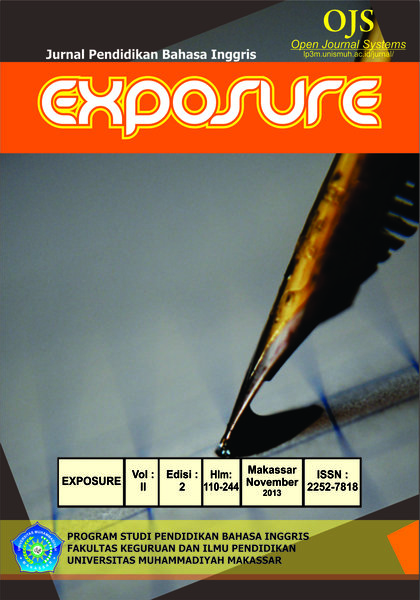INCREASING THE STUDENTS’ SPEAKING ABILITY THROUGH BAMBOO DANCING METHOD
DOI:
https://doi.org/10.26618/exposure.v2i2.790Abstract
The objective of this research was to find out the improvement of the students’ fluency and speaking fluency through bamboo dancing pairs and to find out the improvement of the students’ fluency in speaking through bamboo dancing pairs. The researcher used a class Action Research (CAR). The researcher had conducted two cycles, where each cycle consists of four meetings. It employed speaking test as the instrument. The number subject of the research is 24 students in class V11. A. The researcher took data of real from the school to know the students’ speaking fluency. The research findings indicated that the use of Bamboo dancing Method increased the students’ speaking fluency. From the Table 1 indicated that there was increase the students’ speaking fluency from cycle I to cycle II, whereas in cycle I the students’ achievement was 5.5 and in cycle II the students’ achievement was 7.2. Then from the table two indicated that there was increase the students’ speaking fluency from cycle I to cycle II, whereas in the cycle I the students’ achievement was 5.9 and in cycle II the students’ achievement was 7.8. From this findings, the research made a conclusion that by using Bamboo Dancing method could improve the students’ motivation in speaking fluency and make the students’ active to speak in a learning process.
Keyword: Increasing, speaking, ability, bamboo, dancing, method
References
Arikunto, suharsini (2005). Procedure Penelitian: Suatu Pendekatan Praktek. Jakarta: PT. Rineka Cipta.
Birney. D. (1976). Teaching Oral English. New York. Inc.Longman ClarH.
Herbert. At all (1977). Psychology and Language. New York:hacant Bace
Javo Vich Publisher.
Depdikbud, 1989. Garis- Garis Besar Program Pengajaran (Kurikulum 1994) Untuk Sekolah Menengah Umum. Depdikbud
Djamarah, Syaiful, Zain, Aswan (2002). Srategi abelajar amengajar. Jakarta: PT. Rineka Cipta.
Gay,L.R.(1981). Education Research: Competencies for Analysis and Application. Colombua: Clurles E. Mrril Publishing Company.
Harmer, Jeremy (2001). The Practice in English Teaching. New York: Longman.
Heaton, J. B. 1975. Writing English Language Test. New York: Longman Inc.
Hornby, A.S. (1995). Oxford Advance Learners’ Dictionary. London: Oxford University Press.http://jobs.languagelink.ru/tefl_clinic/teaching_knowledge/teaching approachologies/ppp.php. 5 Nov 2009 17:01:56 GMT.
Longman. 1995. Contemporary English Dictionary. New York. Longman English Contemporary Press.
Webster.1998. Encyclopedic can bridge Dictionary of Language. New York, Portland House.
Downloads
Published
Issue
Section
License
Authors who publish with this journal agree to the following terms:
In order to assure the highest standards for published articles, a peer review policy is applied. In pursue of the compliance with academic standards, all parties involved in the publishing process (the authors, the editors and the editorial board and the reviewers) agree to meet the responsibilities stated below in accordance to the Journal publication ethics and malpractice statement.
Duties of Authors:
- The author(s) warrant that the submitted article is an original work, which has not been previously published, and that they have obtained an agreement from any co-author(s) prior to the manuscript’s submission;
- The author(s) should not submit articles describing essentially the same research to more than one journal;
- The authors(s) make certain that the manuscript meets the terms of the Manuscript Submission Guideline regarding appropriate academic citation and that no copyright infringement occurs;
- The authors(s) should inform the editors about any conflict of interests and report any errors they subsequently, discover in their manuscript.
Duties of Editors and the Editorial Board:
- The editors, together with the editorial board, are responsible for deciding upon the publication or rejection of the submitted manuscripts based only on their originality, significance, and relevance to the domains of the journal;
- The editors evaluate the manuscripts compliance with academic criteria, the domains of the journal and the guidelines;
- The editors must at all times respect the confidentiality of any information pertaining to the submitted manuscripts;
- The editors assign the review of each manuscript to two reviewers chosen according to their domains of expertise. The editors must take into account any conflict of interest reported by the authors and the reviewers.
- The editors must ensure that the comments and recommendations of the reviewers are sent to the author(s) in due time and that the manuscripts are returned to the editors, who take the final decision to publish them or not.
Authors are permitted and encouraged to post online a pre-publication manuscript (but not the Publisher’s final formatted PDF version of the Work) in institutional repositories or on their Websites prior to and during the submission process, as it can lead to productive exchanges, as well as earlier and greater citation of published work (see The Effect of Open Access). Any such posting made before acceptance and publication of the Work shall be updated upon publication to include a reference to the Publisher-assigned DOI (Digital Object Identifier) and a link to the online abstract for the final published Work in the Journal.

